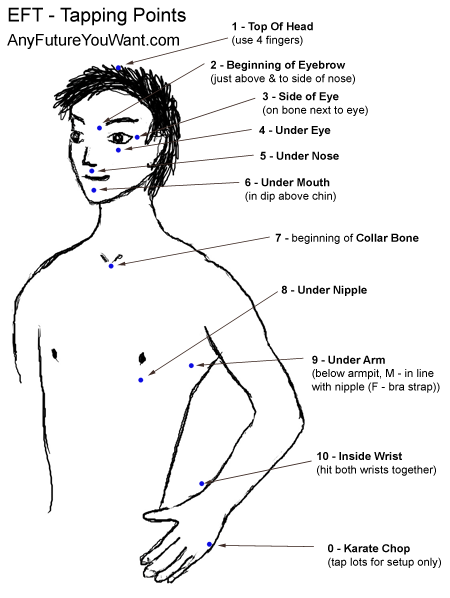How To Prevent Anxiety Attacks
Anxiety attacks are horribly disempowering events. The good news is, you don’t have to suffer from them. You can minimise their effect on you, and yes, even prevent them.
Anxiety attacks are commonly highlighted by the following symptoms:
PHYSICAL
- shortness of breath (or hyperventilation)
- chest pain
- trembling
- light headedness
- heart palpitations
- hot or cold flashes (or burning sensations)
- sweating
- nausea
- feeling dizzy or faint
MENTAL/EMOTIONAL
- an urge to escape (the fight-or-flight reflex)
- fear of losing control
- feelings of unreality
- feeling detached from oneself
- irritability or restlessness
- sense of impending death
(et bloody cetera – don’t follow this link unless you want an instant case of hypochondria)
Of course if you’re prone to anxiety attacks then experiencing any of these symptoms is likely to lead to the fear of having an attack, thus resulting in a feedback loop leading to.. you guessed it, a fully fledged panic attack.
*sigh* this is, of course, not so helpful.
On an energetic level all of the above can by summed up by this: our energy system is freaking out.
Remember – everything in our system works in conjunction. It doesn’t matter what initially kicks off an anxiety attack, once it starts, EVERYTHING will go nuts – physical, mental, emotional and energetic.
The good news is, this leads us to absolutely the most efficient way of dealing with any anxiety attack.
This is something I’ve tested both on myself and many other people, and it invariably takes you from hyperventilating freak-out to completely calm and peaceful in a couple of minutes.
In a word (well ok, an acronym)? EFT.
So – a quick summary.
Here are the points:
[point 7 is actually an inch down and an inch across to either side of that point]
First drink some water if possible (it helps when shoving energy around your body).
Then simply tap 5-10 times on each point (much like tapping on keyboard or screen). Going through all the points, from the top down is called “one round” (coz you’ve gone all the way round – really folks, this isn’t rocket science).
Generally when people are starting out with EFT, one common worry is “what do I say while I’m tapping?”
If you’re having an anxiety attack, this is the easy bit.
You don’t NEED to say anything. The energy is right near the surface (hence the freaking out), so it’s already primed to exit our system.
The feelings have come up because they want to leave (in a manner of speaking). All we have to do is stop fighting, stop resisting, and let them go.
In general, we only talk about things while tapping to keep our mind focused, or to talk through the issue. It may help us feel our way around the problem, but it’s not strictly necessary.
I’ve tested EFT on anxiety attacks a ton of times, and doing even a couple of rounds will take you from completely freaking out to calm in as little as a few minutes.
More usefully, it helps even if you’re not having a fully fledged attack.
I have moments where I get a bit grumpy or a tad upset by what’s going on around me.
A lot of the time I won’t even necessarily be able to put my finger on what exactly is bothering me so much.
My girlfriend (bless her) sees when I’m getting a bit like this, sits on me and taps me.
Pretty much every time this happens, at the start I’m all “yeah yeah, whatever. I don’t fucking care. I don’t need this” (I’ll still let her, coz she’s smarter than I am) but after even 30 seconds of tapping I’m feeling better. After a couple of minutes I’ll be right back to my usual calm, happy self.
So, if you feel things start to spiral, the single best thing you can do is lock yourself away somewhere and start tapping.
If this isn’t possible (eg you’re somewhere public), either just rubbing/tapping on the sore point (point 7 above), or finger-tapping is a good way to get 80% of the effect without getting arrested in the process.
One word of warning, if you’ve dived into a bathroom somewhere, try to be quiet, coz if anyone walks in, it’ll sound a bit like.. well.. *cough* you’re having the wrong kind of fun in there.
I’ve saved the best till last though. Unlike other methods of dealing with anxiety attacks (eg, 5-2-5 breathing – breath into your stomach, hold for 5 secs, then again for 2 secs, then for 5 secs), using EFT actually HEALS the issue.
What I mean by this is – not only does it calm you down super fast, but it also helps reduce (or removes completely) the likelihood of you freaking out in the same situation in the future.
Better yet, you can pre-empt any attacks. If you know the kind of thing that stresses you out, you can tap on it at a time when you’re feeling calm.
For example, I used this when speaking at a wedding a while back – just nicked off to the bathroom beforehand for a quick couple of rounds (ha ha, that sounds so bad). The important thing is, it drained all the excess energy away and left me super calm and cool. Worked a treat.
If all this sounds too good to be true, I don’t blame you in the slightest. I felt exactly the same way when I first found EFT (and, frankly, a lot of the stuff I discuss on here, until I tested the hell out of it all).
As always, don’t believe me. Check it for yourself.


